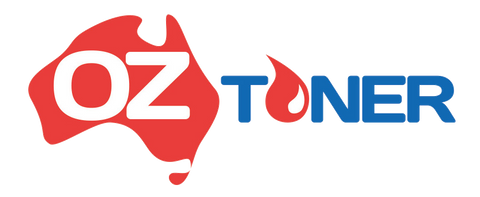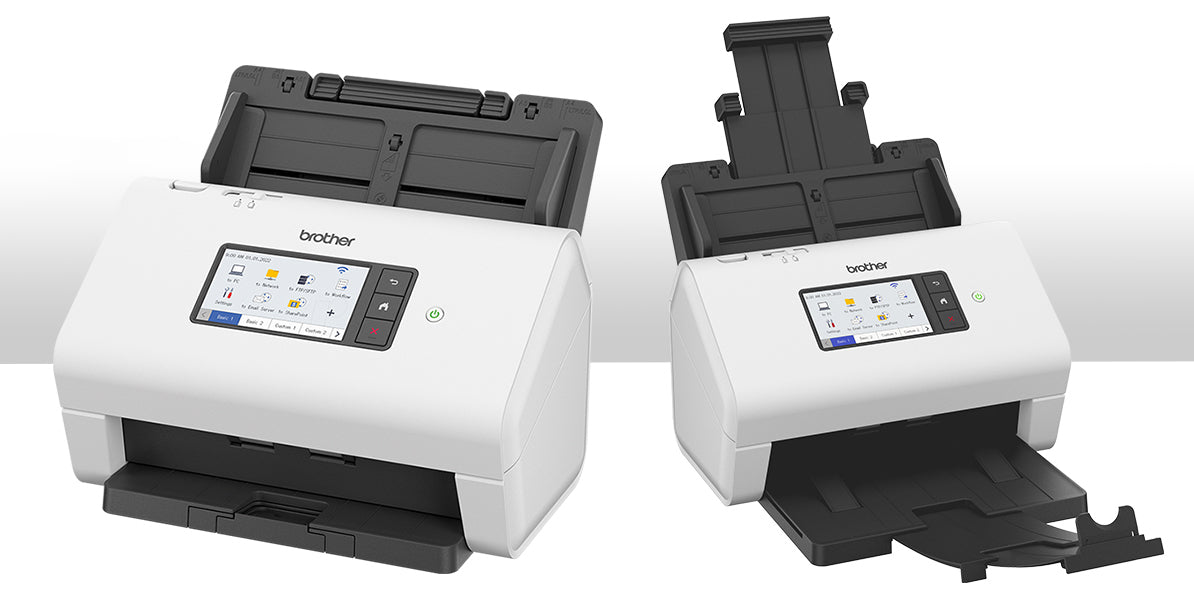-
PROS
- Relatively fast scanning with accurate OCR
- Solid document-management features
- Versatile connectivity and mobile device support
- Scan to USB flash drives without a computer
- Large touch-screen control panel
- Three-year warranty
-
CONS
- Lacks comprehensive Mac support
BROTHER ADS-4700W SPECS
| Automatic Document Feeder | |
| Ethernet Interface | |
| Film Scanning | |
| Flatbed |
A step down from our recent midrange to high-volume Editors' Choice among document scanners, the Brother ADS-4900W, the ADS-4700W Professional Desktop Scanner reviewed here lists for about $230 less ($469.99). For those savings, you get a slightly smaller automatic document feeder (ADF) for sending multipage documents to the scanner; lower scanning and processing speeds; and a lower-volume daily duty cycle. This positions the ADS-4700W for small and home-based to midsize offices, making it a direct competitor to the Fujitsu ScanSnap iX1600, our Best of the Year 2021 pick for SOHO (small office/home office) users. The Fujitsu remains the best choice, but the ADS-4700W is an excellent sheetfed document scanner and a worthy alternative to our current midrange favorite.
One of Many Terrific Sheetfed Scanners
The ADS-4700W ranks second in Brother's sheetfed scanner lineup, behind the abovementioned ADS-4900W and above the ADS-4300W, ADS-3300W, and ADS-3100 (all of which are slated for review here in the weeks ahead). Weighing 6.4 pounds and measuring 7.5 by 11.7 by 8.5 inches (HWD) with its trays closed, this Brother is about two and a half pounds lighter and an inch or so smaller in all directions than the flagship ADS-4900W.
It's also more compact than many of its competitors, which are legion. Besides the ScanSnap iX1600, buyers considering this document scanner are likely to cross-shop the HP ScanJet Pro N4000 snw1, the Epson RapidReceipt RR-600W and DS-790WN Wireless Network Color Document Scanner, the Canon imageFormula R50, and the Raven Original Document Scanner (the heaviest at 9.8 pounds), to name a few high-rated examples.
Like most sheetfed document scanners, the Brother ADS-4700W can extend in height and length to as much as three times its closed or idle size when you extend its paper trays, as seen below.
 Like its rivals, the ADS-4700W takes considerably more desk space when in use than when closed.
Like its rivals, the ADS-4700W takes considerably more desk space when in use than when closed.
Despite being more petite than its ADS-4900W sibling, the ADS-4700W has an identical, customizable 4.3-inch color touch screen control panel accompanied by Back, Home, and Cancel navigation buttons. Above the control panel at top left, you'll find a switch that toggles between continuous feed and manual/single-sheet mode.
 You can set up and execute scans or select workflows from a roomy color touch screen.
You can set up and execute scans or select workflows from a roomy color touch screen.
Users and groups can design and fill separate touch-screen menus with their own sets of profiles and shortcuts, renaming tabs along the bottom of the display (Basic 1, Custom 1, and so on) to indicate owners, functions, or both. You can create up to 56 shortcuts in each panel.
From here, you can configure and execute scan jobs on the fly and choose workflow shortcuts that combine settings such as one- or two-sided (simplex or duplex) scans, resolution, destination, output format, and more. Maximum optical resolution is 600dpi (1,200dpi interpolated), and supported document sizes range from 2 inches square to 8.5 inches wide by 16.4 feet long. Color depth is 24-bit and grayscale is 8-bit.
Possible scan destinations include local drives, email, FTP or social media sites, and cloud sites. Out of the box, the ADS-4700W supports Box, Dropbox, Evernote, Expensify, Google Drive, OneDrive, OneNote, and SharePoint Online. Output formats range from image, searchable, secure, or signed PDF to single- and multipage TIFF, BMP, plain text, and Microsoft Word, Excel, and PowerPoint.
Packaged with the scanner are various flyers and a setup guide, a USB 3.0 cable, and a power adapter and cord. You download Brother's ScanEssentials software from the company's support site.
 The ADS-4700W comes with USB and power cables as well as a setup guide and informational flyers.
The ADS-4700W comes with USB and power cables as well as a setup guide and informational flyers.
The ADS-4700W's automatic document feeder holds up to 80 pages and its maximum daily duty cycle is 6,000 scans (compared to 100 pages and 9,000 scans respectively for the more robust ADS-4900W). That's about average for a midrange document scanner.
For comparison, Epson's DS-790WN and RR-600W each have 100-sheet ADFs and daily maximums of 7,000 and 4,000 scans respectively. The Canon R50's ADF holds 60 sheets and its daily duty cycle is 4,000 scans. The Fujitsu iX1600, Raven Original, and HP ScanJet Pro N4000 all have 50-sheet ADFs; the ScanSnap can handle 6,000 scans a day while the HP and Raven can do 4,000.
Connecting to and Using the ADS-4700W
Standard interfaces include Ethernet, 802.11/b/g/n Wi-Fi, connecting to a single PC via a USB 3.0 or 2.0 cable, and Wi-Fi Direct. The last, as you know, is a peer-to-peer networking protocol that lets handheld devices such as smartphones and tablets connect to the scanner without either it or them being on the same network.
Other mobile options include Apple AirPrint, Brother Mobile Connect, and Scan to Mobile, and you can avoid PCs and phones altogether by scanning directly to a USB flash drive or other USB storage device via a port located on the back of the scanner.
 Interface choices include Ethernet, Wi-Fi, Wi-Fi Direct, USB 3.0, and direct scanning to flash drives.
Interface choices include Ethernet, Wi-Fi, Wi-Fi Direct, USB 3.0, and direct scanning to flash drives.
Brother Mobile Connect works with Brother's standalone and all-in-one printers as well as the company's scanners. When you add a Brother device to this Android or iOS app, the software configures itself for the options available on that machine.
For Windows and macOS desktops and laptops, you get iPrint&Scan as well as ScanEssentials and Kofax PaperPort SE with OCR for Windows. The first two are scanner interface utilities, though ScanEssentials (seen below) is, as its name suggests, a straightforward scanner interface and basic document management program.
 Brother's ScanEssentials combines a scanner interface with document management features.
Brother's ScanEssentials combines a scanner interface with document management features.
Kofax PaperPort is, like other versions of this software, a combination scanner interface and document archiving front end with a variety of features such as systematic file naming and directory structuring, optical character recognition (OCR), and databases of keywords and phrases.
Finally, you get a handful of third-party drivers including TWAIN, WIA, ISIS, and Sane that let you connect to any of the many applications such as Microsoft PowerPoint and Word and Adobe Photoshop and Acrobat that support scanning into them directly.
Testing the ADS-4700W: Competent Speeds, Excellent Accuracy
Brother rates the ADS-4700W's scanning speed at 40 one-sided (simplex) pages per minute (ppm) and 80 two-sided images per minute (ipm), with each page side counted as an image). Again, that's average for a small-to-midsize-office document scanner, though the Epson RR-600W (35ppm and 70ipm) and DS-790WN (45ppm and 90ipm) offer slightly different speed ratings. The higher-volume Brother ADS-4900W is rated at 60ppm and 120ipm.
As usual, I tested the scanner over a USB connection to our Intel Core i5 testbed running Windows 10 Pro and the scanner maker's software, ScanEssentials. I ran a few tests with some of the other bundled apps but none performed notably better.
Our first test entails clocking the scanner and software as they digitized, converted, and saved both our one-sided 25-page and two-sided 25-page (50 scans) documents as image PDF files. The ADS-4700W averaged 43.3ppm and 84.7ipm, which is right on the money for the machines discussed here (excluding the slower RapidReceipt and faster ADS-4900W).
Next, I timed the ADS-4700W as it scanned our two-sided 25-page text document and then converted and saved it to the more versatile and document-management-friendly searchable PDF format. The Brother took an average of 35 seconds to scan and save all 50 pages, also as expected for this level of scanner.
As we've pointed out in numerous reviews, optical character recognition has become a mature technology that consistently churns out accurate, editable text. The ADS-4700W and ScanEssentials produced error-free searchable text down to 5 points in our Arial (sans-serif) font test and 6 points in our Times New Roman (serif) test. Most of the other scanners mentioned here scored 6 points error-free with both fonts, which is a negligible difference.
I also scanned a few stacks of business cards and a pile of receipts and other financial documents, just to see how accurately the software gleaned and archived contact and financial data. Like most other modern scanners and their software, accuracy was excellent as long as the text was legible (i.e., business cards didn't go crazy with color fills and other design elements).
Verdict: What's Not to Like?
When reviewing document scanners in this SOHO and midsize segment, as we've said lately, it takes some discipline to avoid handing out too many Editors' Choice awards. There are a lot of fine midrange scanners available, and they can't all be favorites, so the Brother ADS-4900W remains our top choice.
That said, the Brother ADS-4700W is a terrific, relatively fast scanner with a wealth of higher-end features and connectivity options, not to mention a three-year warranty. Unless you're hoping to save money with an entry-level device or need a more powerful one to handle higher volumes, we can't think of a reason—short of needing the absolute best in class—not to recommend the ADS-4700W to busy offices.



